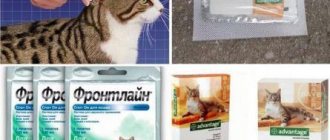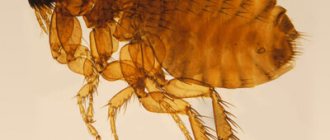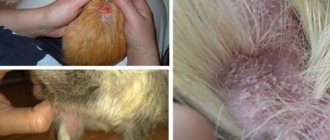No cat is immune from the danger of parasite infection. It’s not at all difficult for your pet to pick up fleas and ticks; just go for a walk in the yard, sit on the balcony in warm weather, or play with another animal that you brought to visit. An infected cat not only becomes susceptible to various infectious diseases and becomes irritable, but can also infect the owner. To avoid this, you should not neglect regular treatment of your pet for parasites.
How can you tell if your cat has fleas or ticks?
If the cat is domestic, then it is extremely important to immediately notice that it has been attacked by blood-sucking parasites. Otherwise, they will not only move on to other animals living in the house, but will also damage the upholstery, linen and belongings of the owner. Therefore, if the following signs appear, you should either check the animal yourself for the presence of fleas, or take it to the veterinarian:
- The appearance of scratches, redness, protruding blood, irritation or inflammation on the skin;
- Detection of small dark spots in the fur, similar to dandruff;
- The fur lost its well-groomed appearance, stopped shining, and its loss became more frequent;
- The animal has become irritable, aggressive, and constantly itches.
It should be understood that even one flea that appears on a cat will not disappear by itself. Such parasites tend to multiply quickly, and they can also infect the animal with worms.
Signs of ticks in a cat are as follows:
- A significant increase in body temperature and, as a result, complete apathy, reluctance to leave your bedding and eat food;
- Dehydration and sudden weight loss;
- Vomiting and diarrhea, accompanied by cough and shortness of breath;
- Yellowing of the skin;
- The mucous membranes turn from pink to gray or white;
- The hair begins to fall out and redness of the skin is observed in bare areas.
Contraindications for use
The drops pose the greatest danger to nursing cats with small kittens aged from birth to four months. A cat may perceive the drops on her children as an attempt to wean them from their mother, and will begin to lick them profusely, which can lead to severe poisoning.
Also, small kittens, while playing, can accidentally bite each other and also “eat” substances harmful to their fragile organisms. A healthy adult cat in such a situation may simply feel unwell and not touch food for several days.
There are cases when insecticides can cause allergies in a cat, hair loss at the site of application of the drops, and even dermatitis. However, these cases are extremely rare, and before use, you should apply a small amount of the product to the paw or side of the animal's body to check the reaction.
But for fleas, the drops pose a mortal danger. Most parasites die instantly as soon as they come into contact with the place where the drops are smeared . The rest immediately run away from the cat’s body, wanting to hide from the unpleasant smell as soon as possible. If you have rid your cat of fleas, and you have a budgie, then a flea can easily settle on the bird. Read about treating parrots for these parasites here.
What blogs look like in a cat's fur
How to properly apply flea and tick drops to a cat?
First, let's determine what effect drops from fleas and ticks have on a representative of the cat breed. Depending on the drug and its manufacturer, drops applied to the skin can repel parasites and prevent a bite, or, if an attempt is made to bite, cause death. Which drops are best to choose depends on where the animal lives. If indoors, the owner is unlikely to be happy with live parasites jumping around the house, but it is much easier to remove dead ones by combing or bathing. Among the manufacturers of veterinary preparations on the market, Bars drops have proven themselves well, and they can be found for animals of different ages.
Cause of fleas in cats
Blood-sucking parasites are capable of existing outside the animal for a long time. Eggs and larvae can develop in the environment and only then end up on a future host. Even one insect will be enough to start the process. Most infections occur on the street. No measures to prevent a domestic cat from communicating with stray animals will help: the parasite will always find a way to cling to hairs on a person’s skin or clothes. After this, the infection begins to multiply rapidly, spreading to upholstered furniture, carpeting and the animal’s bed.
Stay-at-home cats who do not have the opportunity to walk outside are also at high risk of parasitosis. As a rule, the person himself acts as a carrier. On the outer clothing of the owner or family members of a stray cat or dog, a flea can enter an apartment or house and spread through the fur of all the furry inhabitants of the apartment.
From a mother infected with bloodsuckers, all offspring become infected. The number of them on babies can be noticeably greater than on an adult cat. Rodents living in the yard also become carriers. There are a lot of ways to get infected. The main goal of the owner is to carry out effective preventive measures, and in case of trouble, begin treatment on time and prevent it from spreading throughout the house.
Where should I put flea drops on my cat?
The main condition when treating an animal against parasites is that the medicine should be dripped onto those areas of the skin from which it will not be licked off later. Therefore, it is best to apply the drops to the space between the back of the head and the shoulder blades. The drug is dripped onto dry, clean skin; the fur should first be parted. After the procedure, it is not recommended to comb or wash the cat for 2-3 days.
General Tips
Most cats that live a purely domestic life and never leave their home do not become infected with fleas, and therefore do not need treatment. If your cat cannot live within four walls and craves freedom, then the appearance of fleas is inevitable . And once they appear, then you need to get rid of them correctly. It is necessary to choose drugs carefully, for a long time and very seriously. Before self-medicating, it would be a good idea to go to a veterinary clinic and get a consultation. When choosing a medicine, your first priority should not be price and availability, but safety and effectiveness. Remember that the life of your pet is strictly in your hands, and under no circumstances should you skimp on it!
Benefits of using flea and tick drops
To prevent and remove parasites from cats, specialized collars, sprays, shampoos, injection tablets, powders and drops are used. But if earlier owners preferred collars, now they appreciate the effectiveness of drops.
Among the main advantages of using drops against fleas and ticks are the following:
- Safety for the health of the pet, of course, subject to the instructions on where to apply the drug and in what quantity;
- Quick and strong effect on parasites;
- Ease of use;
- Guaranteed effect from several months to six months;
- The ability to treat your pet immediately against ticks, fleas, and worms with one product.
Please note that drops cannot be used for small kittens. And when choosing drops, be sure to look at the age of the animal and its weight indicated on the packaging.
How do the drops work?
Anti-flea drops are liquid solutions of insecticides that are practically not dangerous for warm-blooded animals. The active substances used are:
- permethrin. It is safe for cats and kittens, because after it enters the stomach - if the animal accidentally licks it off - it quickly breaks down and does not enter the bloodstream. The pet will not get poisoned;
- fipronil. Safe type of drug. Can be practiced with young animals;
- pyriprofexin. Today it is the basis for the drip form. Previously, it was part of the compositions with which collars were impregnated;
- ivermectin. A universal insecticide that has an effect on fleas, ticks, lice and nematodes.
Some anti-flea solutions not only act as a poison, but also repel blood-sucking parasites. Their main advantage is ease of application and quick action. Insects sitting on the mugs simply jump off the owner after application.
Video on how to treat a cat for fleas
Popular questions
If an animal has licked drops of parasites, then you should immediately give it activated carbon or any other sorbent. Signs of severe poisoning include vomiting, salivation and convulsions. Any antiparasitic agents are toxic, so the cat must be taken to a veterinarian for further cleansing of the body.
Flea drops are absorbed into the cat's epidermis within 12-24 hours. Therefore, during this time, you should avoid contact with the animal, that is, do not pet or pick it up, and do not allow other pets to lick it.
No. The simultaneous use of several drugs is strictly prohibited, otherwise intoxication may occur. But after treating a cat with drops, you can, for example, wear a flea collar 1-2 weeks later to prolong the effect.
Application methods
In order for the drops to work as effectively as possible and permanently exterminate fleas, it is enough to part the animal’s fur in the right place, thoroughly rub in a couple of drops of the product and not wash the cat for about two to three days. You can also apply a number of drugs along the animal’s spine, which is why the greatest effectiveness is achieved.
Drops are applied to a place inaccessible to the cat’s tongue.
Each drug has its own dosage, and before you start treating your pet, you must also read the instructions. While applying the drops, you must constantly ensure that the animal does not accidentally lick or sniff the product, so that it does not get into the eyes, and if this happens, you must immediately rinse the area with warm water.
What to do if the drops don't help?
There may be several reasons why treatment with drops is ineffective:
- incorrectly selected product;
- incorrect dosage;
- violation of the rules for applying drops;
- using an expired drug.
In addition, the cause may be constant contact with an infected animal or the presence of fleas in the house. In any case, if the applied drops do not help, you should take several steps:
- change the drug;
- treat your house and other pets for fleas;
- try other products, such as a shampoo and collar combination.
Shampoo application
If these measures do not help, you should contact a veterinarian who will help you choose an effective remedy.
What affects the effectiveness of the drops?
First of all, the effectiveness of using drops depends on the correct choice of drug and accurate dosage. It is also important to follow the rules of application, as well as adherence to safety measures.
However, just applying drops to the withers is not enough. It is necessary to clean and treat the room where the pet lives and especially its place - bed, house. The most effective way is to wash the floors with an anti-flea agent and treat carpeting, baseboards, cracks and pet bedding with an anti-flea spray.
Operating principle
Based on the principle of action, anti-flea drops for cats are divided into two main groups:
- contact - after application, the product is distributed over the surface of the skin, absorbed into the upper layer of the epidermis, accumulates in the sebaceous glands and hair follicles and acts on parasites upon contact;
- systemic - the drug is absorbed into the blood and tissues of the animal and enters the insect’s body at the time of the bite.
Opinions among cat owners about the effectiveness and safety of medications vary. Some prefer to use systemic drops, considering them more effective. Others are of the opinion that systemic medications can be harmful to the pet, so they choose contact agents.











